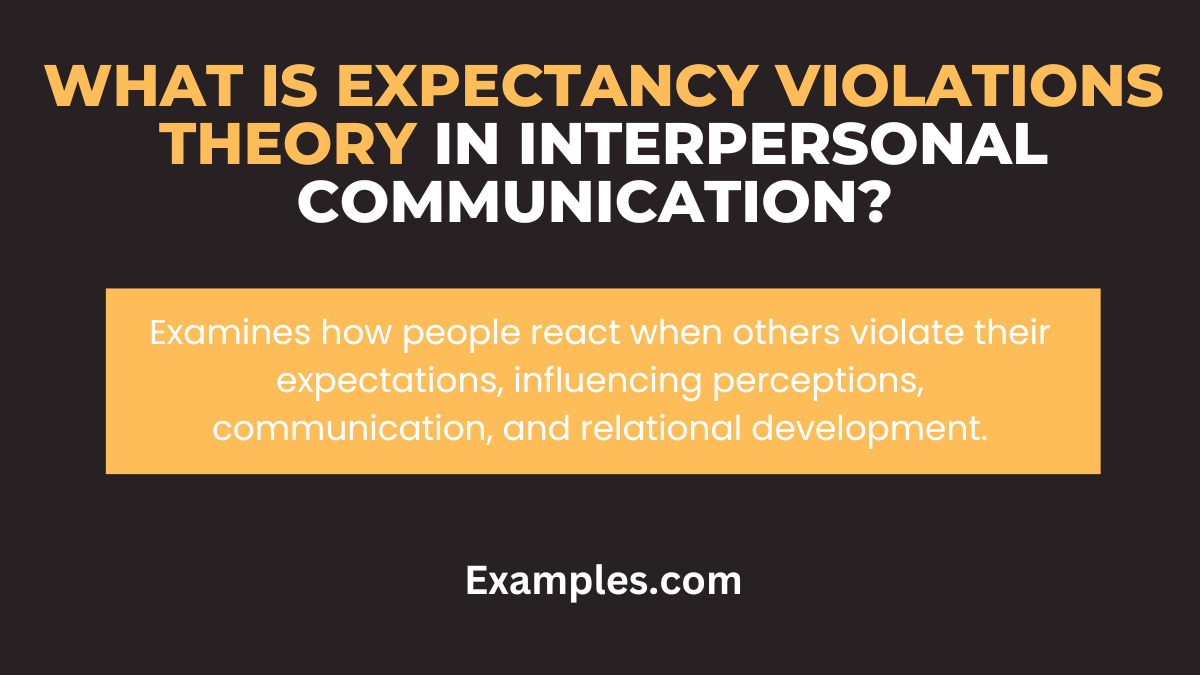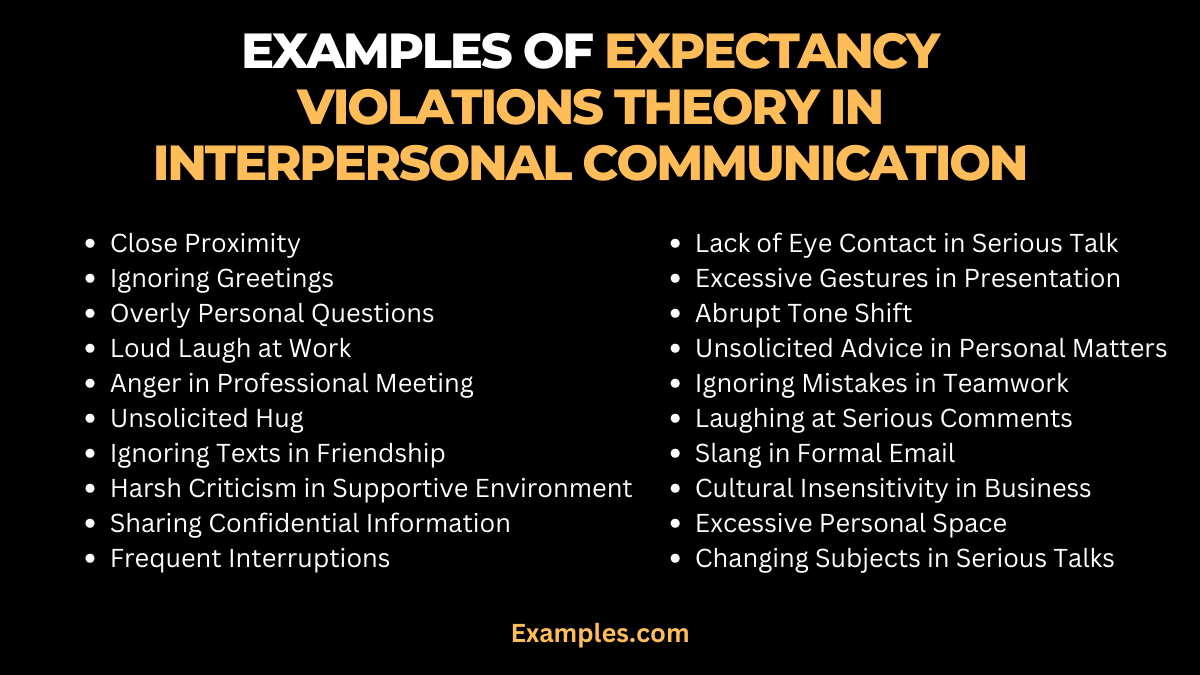19+ Expectancy Violations Theory in Interpersonal Communication Examples
Expectancy Violations Theory (EVT) plays a pivotal role in Interpersonal Communication. This comprehensive guide delves into the nuances of EVT, demonstrating its impact on our daily interactions. Whether it’s in a personal conversation or a professional setting, understanding EVT can significantly enhance the quality of your interactions. We’ll explore real-world examples, shedding light on how expectancy violations occur and their consequences in various communication scenarios. From subtle non-verbal cues to more pronounced verbal exchanges, this guide covers the spectrum of Interpersonal Communication, equipping you with the knowledge to navigate complex communication landscapes effectively.
What is Expectancy Violations Theory in Interpersonal Communication?

Expectancy Violations Theory (EVT) in Interpersonal Communication refers to the way individuals respond to unexpected behaviors of others in various communication contexts. At its core, EVT examines how people perceive and react to breaches in communication norms, which can range from surprising to disappointing. This theory suggests that violations can either be positively or negatively received, depending on factors like the relationship between the communicators, the setting, and the nature of the violation. Understanding EVT helps in better navigating the dynamics of interpersonal interactions, enhancing both personal and professional relationships.
What is the Best Example of Expectancy Violations Theory in Interpersonal Communication?

A classic example of Expectancy Violations Theory in action is when a typically reserved colleague suddenly shares personal information during a formal meeting. This unexpected shift in Verbal Communication challenges the usual norms and can lead to various interpretations among the audience. Some may view it as a positive step towards openness and trust-building, while others might find it inappropriate or discomforting. Such instances highlight the delicate balance of expectancy in Interpersonal Communication. Understanding and anticipating these violations can lead to more effective and empathetic communication strategies, fostering stronger connections in diverse communication settings.
20 Examples of Expectancy Violations Theory in Interpersonal Communication

Expectancy Violations Theory (EVT) in Interpersonal Communication is a fascinating concept exploring how unexpected behaviors impact interactions. This theory highlights how individuals respond to unexpected actions in communication, significantly influencing relationships and perceptions. Understanding EVT is crucial for effective interpersonal communication skills, as it navigates the complex dynamics of verbal and non-verbal cues. Grasping this theory enhances our ability to interpret and respond to surprises in everyday encounters, from personal dialogues to professional settings.
- Close Proximity in Conversation: When someone stands unusually close during a conversation, it may feel invasive, altering the interaction’s dynamics.
How to communicate: “I appreciate our discussion, but could we maintain a comfortable distance?” - Ignoring a Greeting in a Social Setting: Ignoring a greeting can create awkwardness, defying the expected polite response in social interactions.
How to communicate: “I noticed you didn’t respond to my hello earlier. Is everything alright?” - Overly Personal Questions in a New Relationship: Asking deeply personal questions in early stages of a relationship can breach expected privacy boundaries.
How to communicate: “I’m not comfortable discussing such personal matters yet. Let’s keep our conversation light.” - Loud Laugh in a Quiet Office: A sudden loud laugh in a typically quiet workspace can be jarring and disrupt the expected work environment. How to communicate: “Your laughter is infectious, but could we keep the volume down in the office?”
- Public Display of Anger in a Professional Meeting: Expressing anger openly in a professional setting can be unexpected and affect the meeting’s tone.
How to communicate: “I understand your frustration, but let’s discuss this calmly.” - Unexpected Hug from a Colleague: An unsolicited hug from a coworker can be surprising and uncomfortable, violating personal space norms.
How to communicate: “I’m more comfortable with a handshake at work.” - Ignoring Texts in a Close Friendship: Not responding to messages in a close friendship can signal a problem, contradicting expected communication patterns.
How to communicate: “I’ve noticed you haven’t been replying to my texts. Is everything okay?” - Direct Criticism in a Supportive Environment: Direct, harsh criticism in an otherwise supportive environment can feel unexpected and hurtful.
How to communicate: “Your feedback is valuable, but could you phrase it more constructively?” - Sharing Confidential Information in a Group: Sharing someone’s private information in a group setting can breach trust and expected confidentiality.
How to communicate: “It’s important we respect each other’s privacy in our discussions.” - Interrupting Frequently in a Conversation: Constantly interrupting someone goes against the expected flow of a respectful dialogue.
How to communicate: “Could we take turns speaking to fully understand each other?” - Not Making Eye Contact During a Serious Talk: Avoiding eye contact in serious discussions can signal disinterest, contrary to expected engagement.
How to communicate: “I feel more connected when we maintain eye contact during serious talks.” - Excessive Gesturing in a Formal Presentation: Using overly dramatic gestures in a formal presentation can distract from the content, defying expected professional demeanor.
How to communicate: “Your points are great, but maybe less hand movement could help focus on your words.” - Sudden Change in Tone of Voice: An abrupt shift from calm to aggressive tone can be startling and alter the conversation’s direction.
How to communicate: “I’m finding the change in your tone a bit intense. Could we keep the discussion calm?” - Unsolicited Advice in a Personal Matter: Offering advice without being asked in personal situations can overstep boundaries, contrary to expected respect for autonomy.
How to communicate: “I value your perspective, but I’d prefer to request advice when I need it.” - Not Acknowledging a Mistake in a Team Project: Failing to acknowledge a mistake in a team setting can disrupt the expected norm of accountability.
How to communicate: “It helps the team when we all acknowledge our errors.” - Laughing at a Serious Comment: Laughing in response to a serious comment can be perceived as insensitive, violating expected empathetic responses.
How to communicate: “I intended that comment seriously. Could we discuss it without humor?” - Using Slang in a Formal Email: Employing casual language or slang in a formal email setting can seem unprofessional, contradicting expected communication standards.
How to communicate: “For professional emails, could we stick to more formal language?” - Ignoring Cultural Norms in International Business: Disregarding cultural norms in an international business context can lead to misunderstandings, defying expected cultural sensitivity.
How to communicate: “Let’s ensure we’re aware of and respect cultural practices in our international communications.” - Excessive Personal Space During a Friendly Interaction: Maintaining too much distance in a friendly interaction can seem cold, contradicting expected warmth in friendships.
How to communicate: “I feel more connected when we’re a bit closer while talking.” - Unexpectedly Changing the Subject in a Serious Discussion: Abruptly changing the topic during a serious discussion can signal evasion, breaking the expected flow of conversation.
How to communicate: “It’s important to me that we finish discussing the current topic before moving on.”
What does Expectancy Violations Theory in Interpersonal Communication Assert about People?
- Core Assertion: Expectancy Violations Theory (EVT) in Interpersonal Communication suggests that people have expectations for others’ behavior and react differently when these expectations are violated.
- Positive and Negative Violations: The theory distinguishes between positive violations, which can enhance a relationship, and negative violations, which typically harm it.
- Personal Space Expectations: A key aspect of EVT is the concept of personal space and how its invasion can be perceived differently based on the relationship and context.
- Influencing Factors: Variables such as culture, relationship status, and personal preferences influence what is considered a normative behavior.
- Communication Styles: EVT highlights how different types of Interpersonal Communication, like verbal and non-verbal cues, impact expectancy violations.
- Predictor of Behavior: The theory asserts that people’s reactions to expectancy violations are predictive of future interactions and relationship dynamics.
- Subjectivity of Expectations: EVT underscores the subjectivity of expectations, suggesting that what constitutes a violation can vary greatly among individuals.
Key Concepts of Expectancy Violations Theory in Interpersonal Communication
- Expectancy: The anticipation of how others will behave or communicate, influenced by social norms and individual experiences.
- Violation Valence: The positive or negative value assigned to a behavior that deviates from what is expected.
- Communicator Reward Valence: The overall positive or negative attributes of the person committing the violation, influencing how their behavior is perceived.
- Context: The situation or environment in which the interaction occurs, playing a significant role in expectancy formation and violation perception.
- Relationship Factors: The nature of the relationship between the communicators affects expectancies and reactions to violations.
- Culture and Social Norms: Cultural background and societal standards heavily influence what is considered normal or violating behavior.
- Adaptation and Adjustment: How individuals adjust their behavior in response to expectancy violations, reflecting the dynamic nature of interpersonal communication.
Limitations and Challenges of Expectancy Violations Theory in Interpersonal Communication
| Limitation/Challenge | Description |
|---|---|
| Overemphasis on Norms | EVT may overly focus on societal norms, overlooking individual differences. |
| Contextual Variability | The theory’s application varies across different cultural and social contexts, limiting its universality. |
| Subjectivity in Interpretation | Perceptions of violation are highly subjective, making it difficult to predict responses accurately. |
| Complexity in Relationships | EVT simplifies complex relationship dynamics, potentially oversimplifying human interactions. |
| Limited Scope on Communication Types | The theory primarily focuses on non-verbal cues, not fully encompassing all types of Interpersonal Communication. |
| Reliance on Retrospective Analysis | Often, EVT analyzes communication after the fact, which may not accurately capture the nuances of in-the-moment interactions. |
| Ambiguity in Violation Valence | Determining the positive or negative nature of a violation can be ambiguous and vary widely among individuals. |
To conclude, the Expectancy Violations Theory offers pivotal insights into Interpersonal Communication Skills. It explores how individuals respond to unexpected behaviors in communication, emphasizing the significance of context and relationship dynamics. This theory serves as a lens to understand how deviations from expected communication patterns can either strengthen or weaken relationships. By applying this theory, we can better navigate the nuances of interpersonal communication, from workplace dialogues to personal conversations, ensuring more effective and meaningful interactions in various settings.



